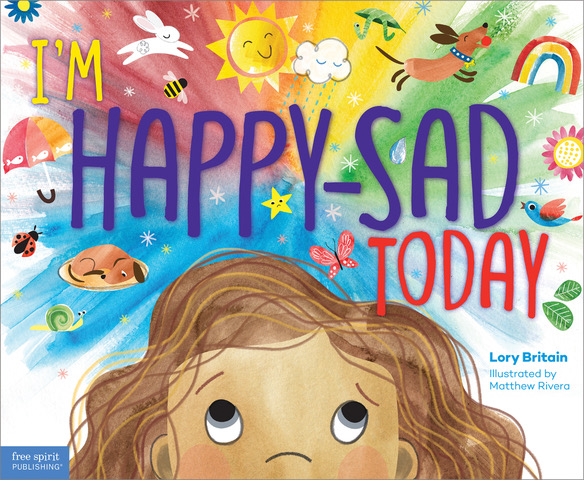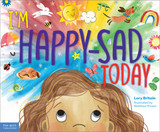Helping Children Make Sense of Mixed Together Feelings
Posted by Lory Britain, PhD Early Childhood Education on Nov 14th 2022

“Grandma, I'm smad!”
The phone rings. It is from my then nine-year-old granddaughter who says, “Grandma, I am so SMAD”. I ask Morgan to tell me more. “I am MAD that my parents made me go to my room and SAD that I am in my room”. Naturally, I supported Morgan sharing her feelings and creative ways to express mixed-together feelings. The incident resonated with me, and I begin work on a new book for young children which later became “I’M HAPPY-SAD TODAY”: Making Sense of Mixed-Together Feelings" (Free Spirit Publishing).
Ten Years Later
I am sitting in the Department of Motor Vehicles office with my granddaughter, now 19 years old. We are #205 in line and the DMV staff are currently serving #116. Long wait …so I begin to work on this article by discussing it with Morgan. I wondered how to best approach writing this article.
A Good Discussion
“Morgan, I realize that I don’t have specific expertise working with children with autism. However, I do believe in being sensitive to a child’s needs, paying attention to body language, considering how they might be feeling and reflecting on the best way to support them. In other words, I try to see how they might be feeling from their vantage point and respond appropriately. “
“Grandma, that is exactly what ALL children need, including children with autism.“ (Note that my very insightful, older granddaughter identifies as being on the autism spectrum.)
Then she added, “I remember hours and hours of lovely interactions with you, exploring, experimenting, pretending, sharing my feelings. I always felt supported by you, Grandma”
“Yes, I always tried to “walk in your shoes” and view each moment from your perspective.”
My Early Childhood Focus
For over forty years, I have been supporting young children’s emotional needs and helping others do the same, from preschool settings, parent groups, college and university settings, child abuse prevention/family support programs, and even throughout Ukraine. I also have incredible respect for those such as my dedicated and talented daughter who work in the field of special education and contribute immensely to children’s well-being.
I recognize that ALL children (and adults, as well) can have multiple feelings about any situation and no one needs to choose one feeling over the other. Giving children tools to express their feelings contributes to their emotional health.
Questions for Reflection
Whether you choose to introduce this “mixed-together” feelings concept by reading “I’M HAPPY-SAD TODAY” and/or by embedding this concept into discussions and events with your child, consider this:
- What is the child’s body language and other non-verbal cues?
- What is your child’s emotional state?
- Are they receptive to a discussion in the moment?
- Would it be better to start to talk about mixed-together feelings before any strong emotions are happening? Or talk during a time of very “big” feelings?
- Is it better to talk afterwards and/or use some approach other than talking?
- Can they apply the concepts across multiple situations?
- Do they have multiple feelings at once or perhaps a cascade of different feelings one after the other either in the moment or over time?
Practical Ideas to Consider
Reading the book: Some adults choose to read the book all the way through with a child without pausing for discussions. Children might prefer it this way as well. Other times it might seem more appropriate to read a few of the scenarios and pause for discussion and comments from your child. Take your cues from the child.
Open ended questions: If you do ask questions, ask open-ended questions. Open-ended questions don’t merely solicit “yes” or “no” responses and usually yield deeper, more meaningful comments.
Modeling: Like all good parenting and teaching practices, adult modeling is an effective way to transmit values to children. Example: If a child starts to cross the street without looking, an adult might say (after making sure the child is safe), “I was scared when you started to cross the street, but happy that you stopped and stayed with me”.
Expression through different modalities:
Providing opportunities for children to express themselves in different ways gives each child individualized ways to express their feelings.
Pretending:
The world of make-believe is one way for a child to express their most hidden issues. If you pretend with them, let the child take the lead, following their suggestions and cues. You can start the pretend with gentle prompts, however. Small toy animals, dolls, etc. can also be used in the pretend play.
Puppets:
Often children will speak directly to puppets when they find it challenging to express their emotions to human beings. This can be an effective starting point for talking about their mixed-together feelings. Sometimes, using one puppet with the same persona encourage special “talking about feelings” time.
Painting and drawing and dance:
Encourage a child to paint or draw showing one emotion and then ask if they have another feeling (or more) they would like to paint or draw on the same picture. Likewise, dancing is a wonderful way to express multiple feelings. Dancing with them is an effective way to model expressing multiple feelings.
Feeling cards/charts:
Traditional use of feeling cards and charts often solicits a child picking one emotion over others. This can be a time to convey that a child can have more than one feeling. Ask them if they would like to pick another feeling after their initial choice. This process could reinforce the multiple ways they feel.
Remember
It is universal to want to be supported and understood, especially children. We all have mixed-together feelings at one point or another. Children feel validated and understood when caring adults in their lives give a clear message that all their feelings are accepted, without having to choose one feeling over the other.
Lory Britain, PhD Early Childhood Education: Above all, my greatest joy is being a mother and grandmother. I have been a beloved preschool teacher, Co-director of University Lab Preschool, respected researcher in Early Childhood education, college and university faculty, science textbook author, trainer, director of a respected child abuse prevention and family program, developer of materials and standards that have been implemented throughout Oregon and in Ukraine. I have written children’s books that support children’s emotional development and are distributed throughout the world in several languages. The most famous ones are It’s MY Body (originally published under the name Lory Freeman) and recently, “I’m Happy-Sad Today”. I continue to write children’s books and create imaginative art.







